Bradysia spp., Orfelia spp.
Once you notice them, flying slightly above your plants or in your face, you can’t ignore fungus gnats.
Somehow, these quiet, tiny flies are as annoying as noisy house flies, and you’re on a mission to deal with them once and for all.

We link to vendors to help you find relevant products. If you buy from one of our links, we may earn a commission.
Luckily, there are a variety of options for safely and effectively ridding your houseplants of the little flies that are emerging from the soil medium.
Everything you need to know about these little maggots is laid out for you below!
Here’s what we’ll cover:
What You’ll Learn
What Are Fungus Gnats?
Fungus gnats, also sometimes called dark-winged fungus gnats, are small flies in the Sciaridae family and Bradysia and Orfelia genera.
They can be irritating and look dirty, flying around your plants, your head, and light sources, but these flies are mainly a nuisance pest.
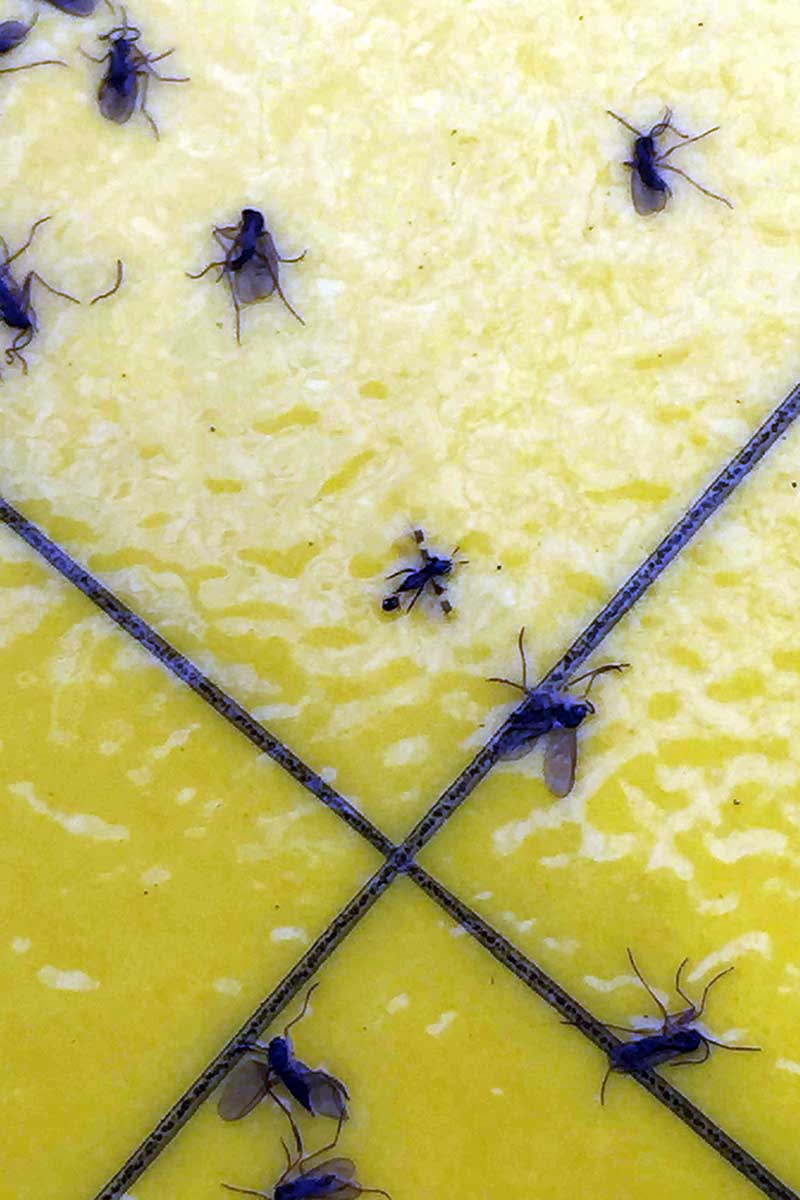
The adults are harmless. However, their maggot-like larvae which live in the soil can cause damage, especially to young plants.
The larvae feed on fungi, algae, and decaying organic matter in the growing medium, but they may snack on root hairs and roots if populations are large.
Through feeding, they can transmit plant diseases such as black root rot caused by various species of Thielaviopsis, Pythium, Verticillium, Botrytis, and Fusarium fungi.
Severely damaged plants may wilt. However, you will usually notice the fungus gnats themselves resting on the growing medium or flying about before this happens, giving you time to deal with them.
Why do they love your indoor garden so much? It’s easy to overwater a houseplant. Plus, houseplants like spider plants last a long time and can spend years in the same pot and medium.
As the growing medium ages, it slowly degrades and holds onto moisture for longer. Moist peat, a common ingredient in soilless mixes, is a preferred substrate for the females to lay their eggs in.
Identification
Adults are black-bodied flies an eighth of an inch in length, with long legs and segmented antennae that are longer than their heads. They have dark, translucent wings that fold over their backs when they are at rest.
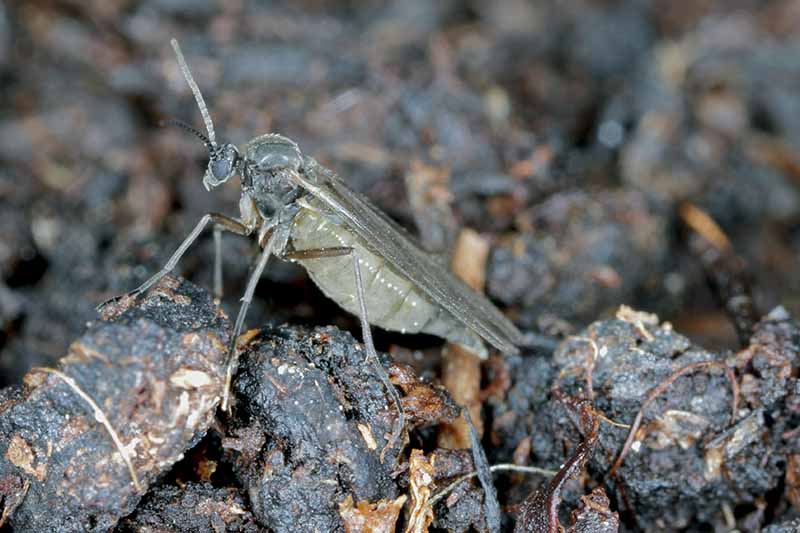
Small, dark, and delicate, fungus gnats are often misidentified as shore flies or fruit flies. To learn more about how to tell them apart, read our guide.
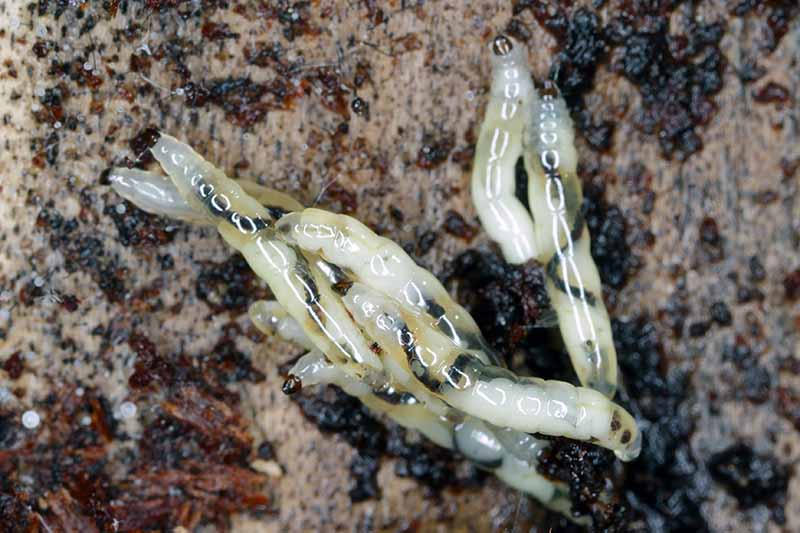
Fungus gnat maggots are tiny, translucent, legless, wormlike larvae with black head capsules. At maturity they can reach a quarter of an inch in length.
Biology and Life Cycle
At a typical room temperature of 65 to 75°F, a fungus gnat’s life cycle can be completed in as little as three to four weeks. On indoor plants, generations overlap, and reproduction occurs year-round.
Adults are very short-lived and don’t feed. Females have a seven- to 10-day lifespan, during which they lay about 200 eggs into moist growing mediums, preferring types with high proportions of peat moss.
The eggs take three to six days to hatch into larvae. The maggots spend their lives eating fungi, algae, and decaying organic matter in the top two to three inches of the soil or soilless growing medium.
When populations are large, they may resort to feeding on plant root hairs, and cause damage to the roots in the process.
The larvae go through four instars over a period of one to three weeks before pupating near the soil surface. Within four to five days, the adults will emerge.
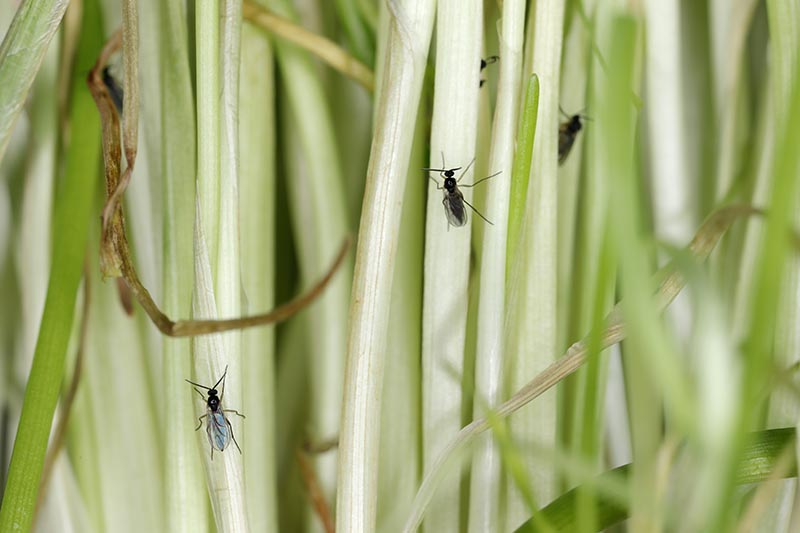
Fungus gnat populations on houseplants often seem to peak in the fall and winter.
One reason for this is that we tend to spend a lot more time indoors during these seasons, so we are quicker to notice tiny insects flying around the plants or against the windows.
Plus, any houseplants taken outdoors during the summer may be colonized by eggs and larvae, and when the plants are taken in for the chilly season, the warmth leads to a population explosion.
Monitoring
When I worked in greenhouses for a living, I’d inhale the odd pest on occasion while walking through a cloud of these flies.
That was a rather unpleasant nudge to indicate that populations had grown, but I monitored these insects with yellow sticky traps and weekly counts, trying to catch them before they reached this stage. Plus, I’d also inspect the soilless medium that we used for larvae.
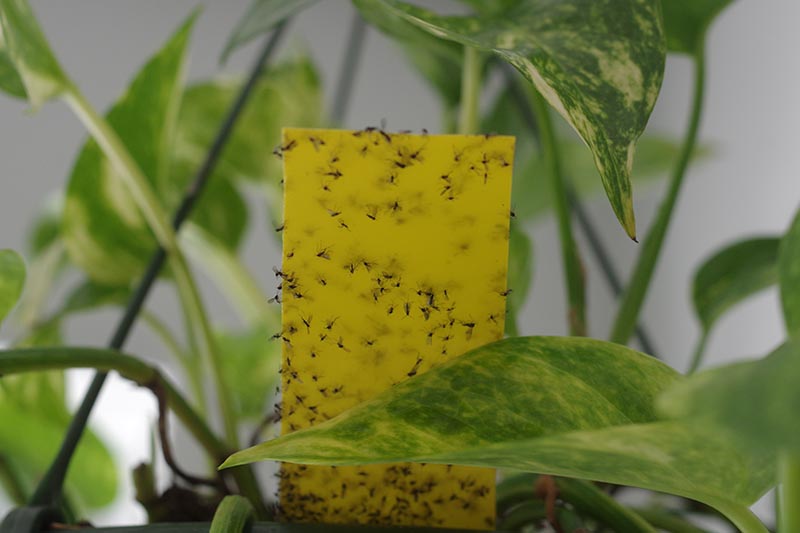
You can use sticky traps in your home to monitor for these gnats too, but they aren’t the prettiest addition alongside your beautiful houseplants.
If you have fungus gnats on your houseplants, you’ll know it. Keep an eye out for them hovering around your plants, resting on the leaves and soil, or flying against your windows and other light sources.
If you wish to actively monitor for the larvae, place a quarter-inch-thick slice of potato on the surface of the potting medium. Fungus gnat larvae will feed on and burrow inside the potato, so check it after a few days, and discard and replace it if it is full of larvae.
Organic Control Methods
It is tempting to bring out the big guns when there are clouds of tiny flies harassing you and your plants, but keep in mind that you are sharing an environment with your plants as well.
Whatever you treat them with must be safe for use around you too, as well as your children and pets.
Luckily, there are a variety of safe, effective methods you can use to combat fungus gnats infestations in your houseplants.
Cultural and Physical Control
If you’re looking for an easy and effective way to deal with these little flies, every reputable source you check will agree on one foolproof method:
Alter the environmental conditions.
Fungus gnats are often associated with overwatered houseplants. Sure, not overwatering your plants is often easier said than done, but saturated potting medium is very attractive to laying females, not to mention the perfect environment for the wiggly baby fungus gnats to develop in.
As an alternative, you can bottom water your plants so the soil surface, where the eggs are laid and larvae prefer to hang out, never stays soggy.
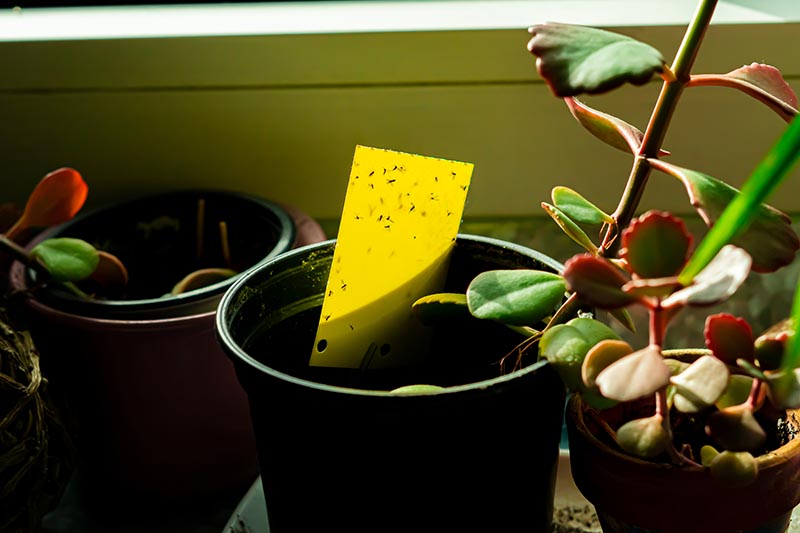
Speaking of healthier plants, make sure they receive adequate light and ideal temperatures for whatever variety you are growing.
Also avoid fertilizing with lots of manure, blood meal, or other products that are high in organic matter, since these flies love these carbon-rich materials when they begin to deteriorate.
Repot your plants regularly, especially when you notice signs of potting medium degradation. These signs include the medium not drying out as fast as it used to, compaction, and a lack of varying particle sizes.
Test how the medium is doing by getting dirty: feel it with your fingers, dig around a little, and crumble a small handful back into the pot. If the medium is hard (i.e. not fluffy), fine, and uniform (i.e. it doesn’t have chunks of different sizes), you may need to repot.
Remove any decaying leaves or other plant bits whenever you see them.
Cover the surface with half an inch of coarse sand or a fine gravel, which will deter the females from laying their eggs.
If you can’t wait until the controls listed above eventually reduce the annoying adult numbers and want to add a trap to your arsenal, you can purchase Enoz BioCare Gnat Stix, which attract and trap the adults.
They are available at Arbico Organics in packs of 12, 24, or 48.
Biological Control
Besides – or in addition to – trying the cultural controls described above, you can also try some biological control options. Many of these focus on the larvae or pupae in the soil.
Steinonerma feltiae nematodes applied to the soil will help to control the larvae.
NemAttack Beneficial Nematodes
These are available for purchase at Arbico Organics in various package sizes.
Simply mix the nematodes in water and apply to your pots with a watering can, pump sprayer, or syringe. Nematode application rates depend on surface area.
For example, five million nematodes (the smallest package size Arbico Organics carries) is enough to treat 1,600 square feet of soil or soiless medium.
Infested larvae will die within three to four days.
The beneficial, soil-dwelling mite Stratiolaelaps scimitus (previously known as Hypoaspis miles) will also help to keep gnat levels low and can be purchased at Arbico Organics as well.
These mites will also attack thrips pupae, so they are extra handy to have living in your containers.
Rove beetles (Dalotia coriaria), available to order from Arbico Organics, are soil-dwelling predatory insects that dine on a variety of pests including fungus gnats, so consider adding these to your armory as well.
Rove beetle (Dalotia coriaria)
These should be employed after repotting has taken place, to make sure you are not disposing of most of the good guys with the old soil.
Organic Pesticides
Thanks to the multitude of easy, safe, and effective cultural, physical, and biological options available, pesticides are often an unnecessary control route, especially in your home.
Even commercial greenhouses rarely treat for fungus gnats if they have a good cultural and biological integrated pest management program in place. Only very severe infestations may call for pesticide use.
If you do decide to apply a pesticide, choose one that’s labeled for indoor use and safe for use around humans and pets.
Pesticides, especially contact types which do not persist for very long such as soaps and oils, are not very effective against this type of pest, and require repeated applications to the soil surface to catch the adults as they emerge. Do not spray the air where the adults are flying.
Try AzaGuard, available at Arbico Organics, which is labelled for fungus gnats and is safe for use indoors in homes where humans and pets live.
Chemical Pesticide Control
Persistent chemicals, such as neonicotinoids and pyrethroids, are the most effective options for use against fungus gnats when it comes to pesticides.
However, chemical pesticides are not recommended for use in the home, and most chemical options are only necessary in commercial spaces when infestations are severe.
Gnat Welcome in My House
Fungus gnats are annoying, potentially harmful insects that can plague your most beloved plants in your own home, not to mention fly in your face and against your windows.
Luckily, there are numerous ways to control and reduce populations without having to resort to pesticides.
The most important step is altering the environmental conditions that favor fungus gnat reproduction. These methods are simple, effective, sustainable, and hopefully mean your houseplants can live gnat free.
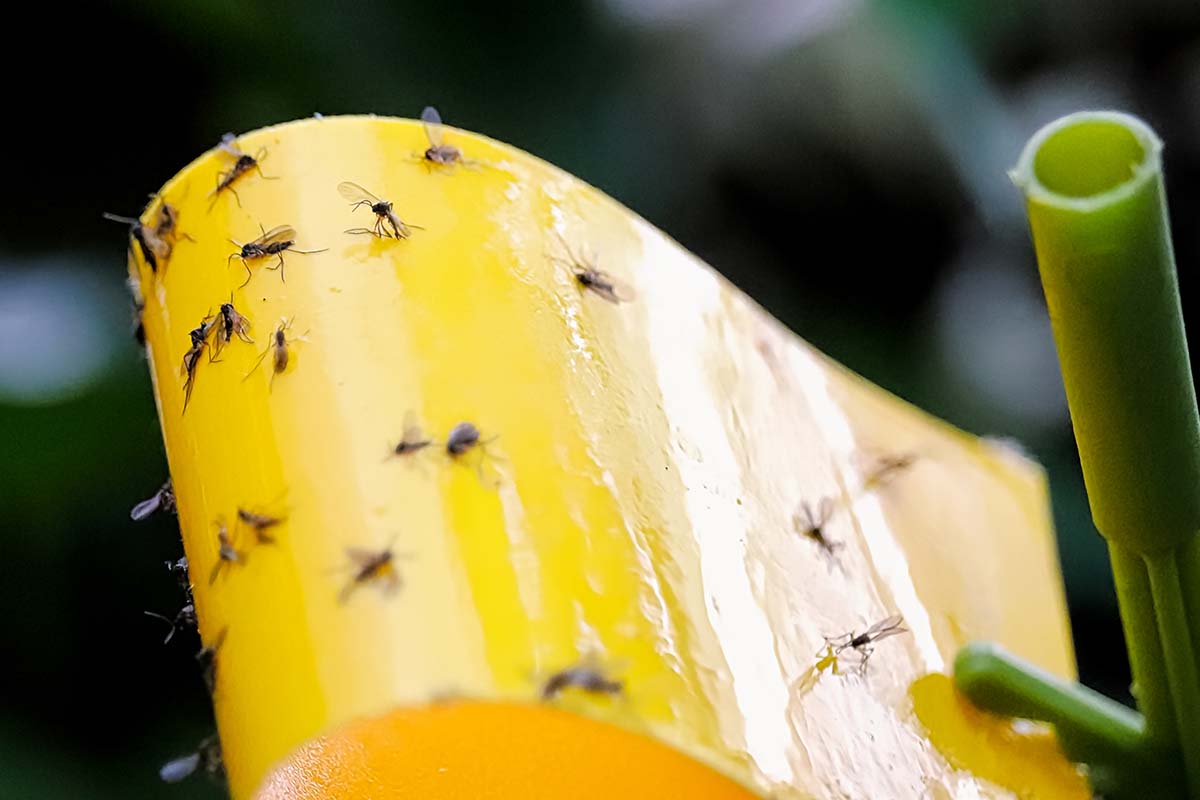
Have you ever noticed these tiny flies in your home? Tell us about how you dealt with them in the comments below.
And while you’re thinking about protecting your houseplants, read about other plant pests here:
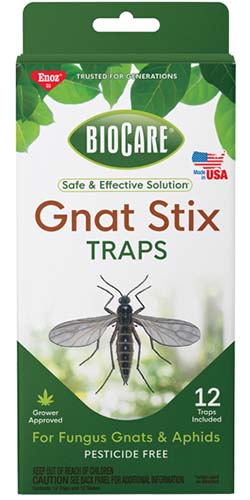


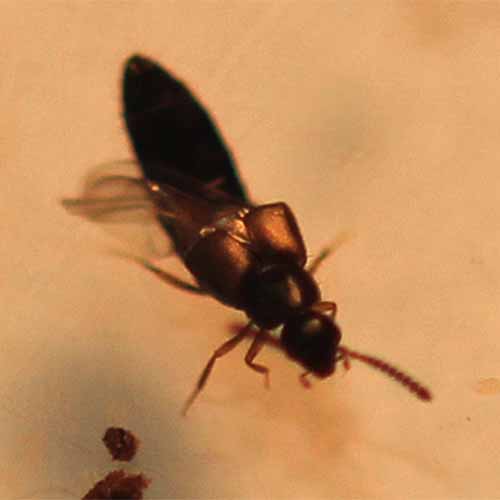
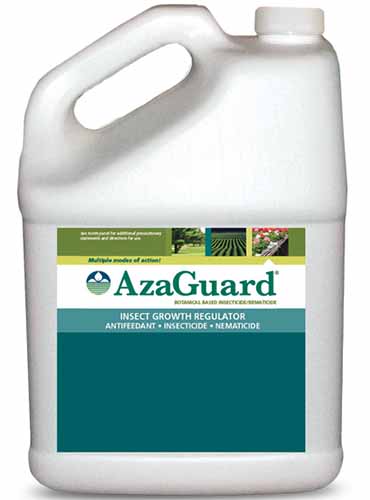
Hello I have some gnats flying around but never seen any like this before they are purple as you can see ..are they fungus gnats
Hi Leigh, I managed to retrieve your pictures.
Hi Leigh, it’s hard to tell the size of the gnats from the image, but these do look like fungus gnats.
I am desperate! These bugs have invaded part of my home. I have no idea what they are or how to get rid of them. Do you have any ideas? I thought they were fungus gnats, but there is no purple.
Hi Kimberly, it’s a little hard to tell from the photo. What size are these flies? It doesn’t look like a fungus gnat from the position, and I don’t see the characteristic antennae. Are they congregating around your plants? Or are they sticking to one area? Do they fly in any sort of pattern (circles, back and forth in front of a window? Let me know and I can try to help.